Welcome to the world of Tupelo honey! For those curious minds wondering, “What is Tupelo honey, and where does Tupelo honey come from?” – you’re in for a delightful journey. This remarkable honey variety hails from the blossoms of the Tupelo tree, celebrated for its lush green leaves and captivating beauty. Here, we’ll unveil the secrets of Tupelo honey, exploring its origin, what comprises this Tupelo tree honey, and the incredible health benefits it offers. Whether you’re a honey connoisseur or a newbie to the honey scene, this dive into the world of Tupelo honey promises a sweet adventure.
What Is Tupelo Honey?
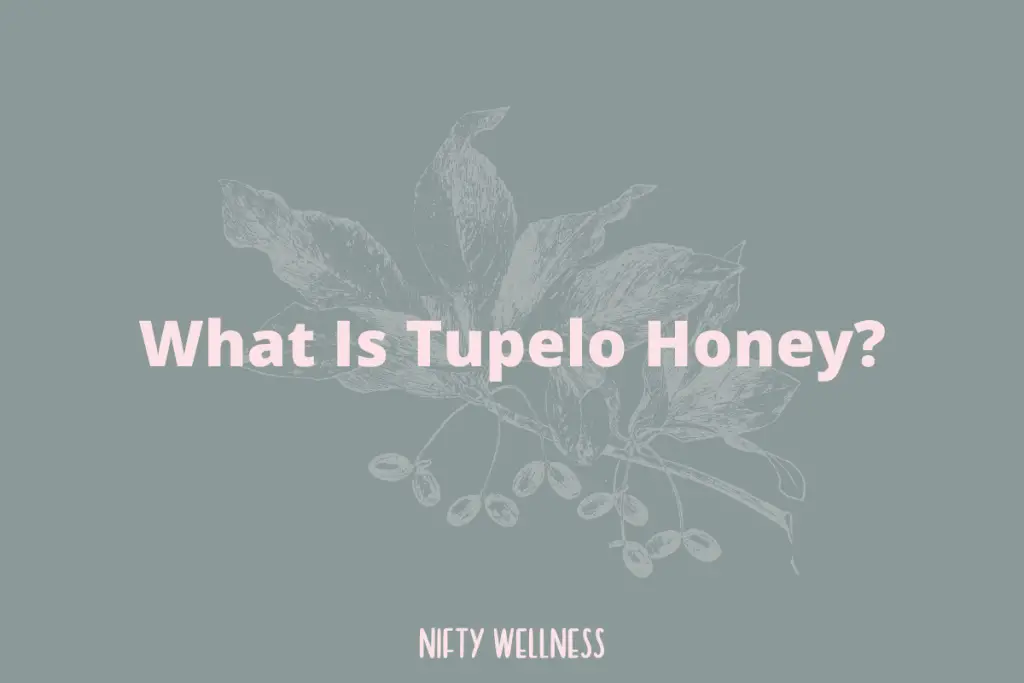
Tupelo honey is a high-grade, mono-floral honey that derives from the White Ogeechee Tupelo trees of North Western Florida and Southern parts of Georgia.
The swamps along Florida’s Apalachicola River valley and Georgia’s Ochlocknee and Choctawhatchee Rivers are where the highest quality of Tupelo honey is produced.
Tupelo trees, also known as Sour Tupelo-Gum, Bee-Tupelo, Ogeechee-Lime Tree, Tupelo Gum, or Swamp Gum, have a short blooming season between April and May.
Some trees have even been known to have a blooming period of as little as three days, which is in part why Tupelo honey is so rare.
Tupelo honey is produced when pollinating honey bees collect the nectar from the white blossoms of the flowering Tupelo trees.
During this season, beekeepers carefully manage the hives surrounding the Tupelo trees to ensure a single flower honey is produced.
As the beekeepers want to keep the beehives as close to the trees as possible, they often have to use boats to access the hives. This is why many locals will refer to Tupelo honey as “swamp honey.”
Tupelo honey is also known as “liquid gold” and “Queen of the Honey World” due to its light golden amber color that often casts a greenish hue in ode to its swampy origins.
Tupelo honey is known to have a floral taste and buttery sweetness with aromas that can often taste fruity and smell of cinnamon.
(Read more about the equally unique orange blossom honey – in a new tab.)
Why Tupelo Honey Is Unique
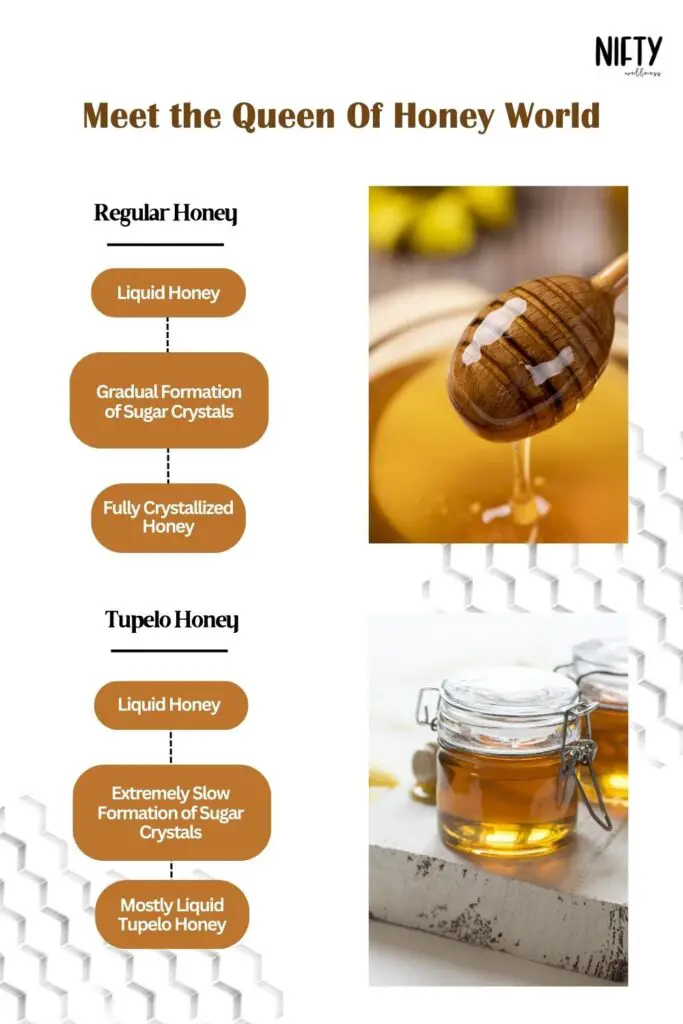
Most types of honey will crystallize over time due to their unstable composition of sugar and water. Honey’s with high glucose concentrations and lower fructose concentrations will crystallize more quickly.
Tupelo honey is an exceptionally special type of honey whose high fructose (44%) and low glucose content (about 30%) means that it has an extremely slow crystallization rate and can thus stay liquid-smooth for years and years.
Tupelo honey’s high fructose content also means the body can release the sugar energy over a prolonged period of time and significantly reduces the feelings of a sugar crash that are so often associated with sucrose or white sugar.
Because of Tupelo’s low sucrose content, some doctors have even allowed people with diabetes to consume this honey. Tupelo honey’s nickname of liquid gold also refers to its price and prestigious value.
Not only does the Tupelo tree have a remarkably short flowering season, but to be able to produce even an ounce of honey takes a lot of energy from bees and trees alike.
Throughout a honeybee’s lifetime, their long, extended efforts will only produce 1/12 of a teaspoon of honey. Similarly, biologists estimate that a Tupelo tree must produce two million flowers in order to produce just one pound of honey.
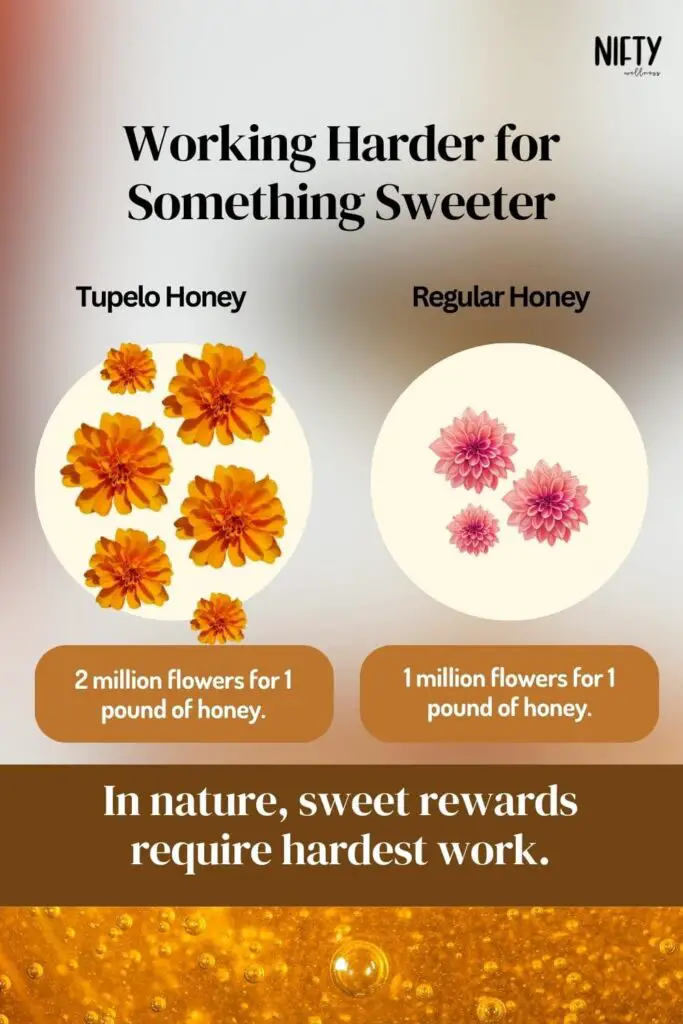
Pure Tupelo Honey
When it comes to producing a mono-floral honey like Tupelo, beekeepers must follow strict guidelines and regularly send their honey in for testing to avoid dilution and misrepresentation.
Tupelo can often be diluted or mixed with gallberry honey, but locals, experts, and beekeepers say that the unique taste of true Tupelo cannot be mistaken.
Pure Tupelo honey, with its distinct taste and outstanding qualities, is a sought-after treasure among honey enthusiasts. Pure Tupelo honey is not only beloved for its exquisite taste but also for its many potential health benefits, making it a prized addition to the world of natural sweeteners.
Check out our blog Chesa Fruits: Nutrition & Benefits Of The Infamous Eggfruit and dive into the world of Chesa fruits nutrition and benefits.
Tupelo Honey Health Benefits

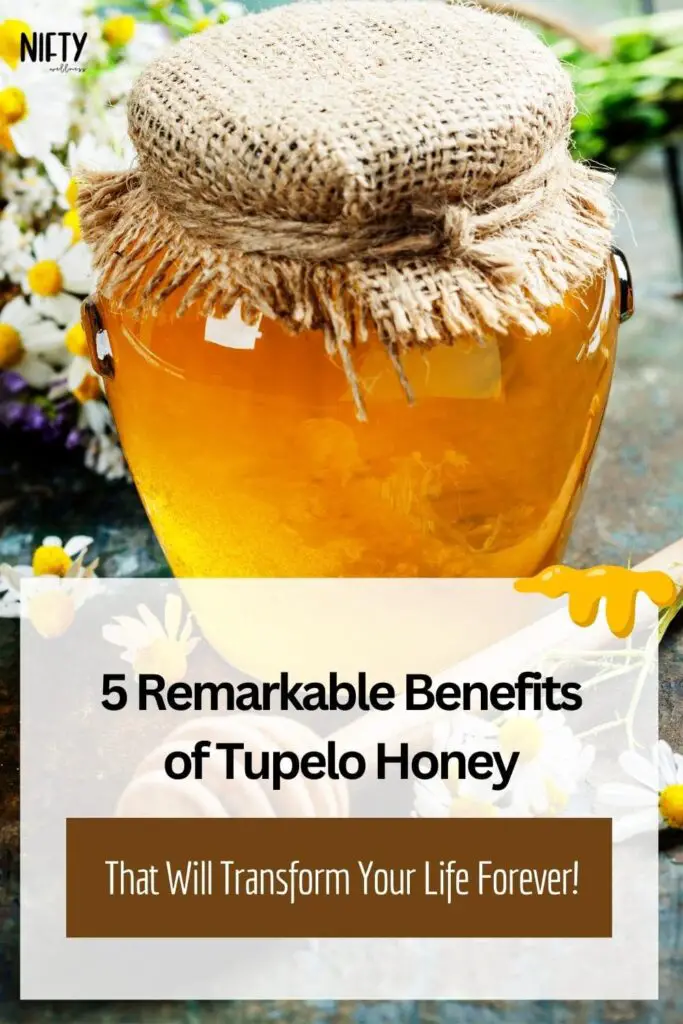
Natural Source Of Sugar
Tupelo honey’s most unique property is its high fructose content, making it the perfect source of natural sugar. Due to its natural sweetness, it serves as an excellent alternative to refined sugars in various recipes and beverages. Tupelo honey releases its sugars slowly in the body, providing a prolonged release of energy.
This is especially great for athletes looking to boost their performance and sustain energy levels or for those with diabetes or who need to watch their blood sugar.
Rich In Nutrients
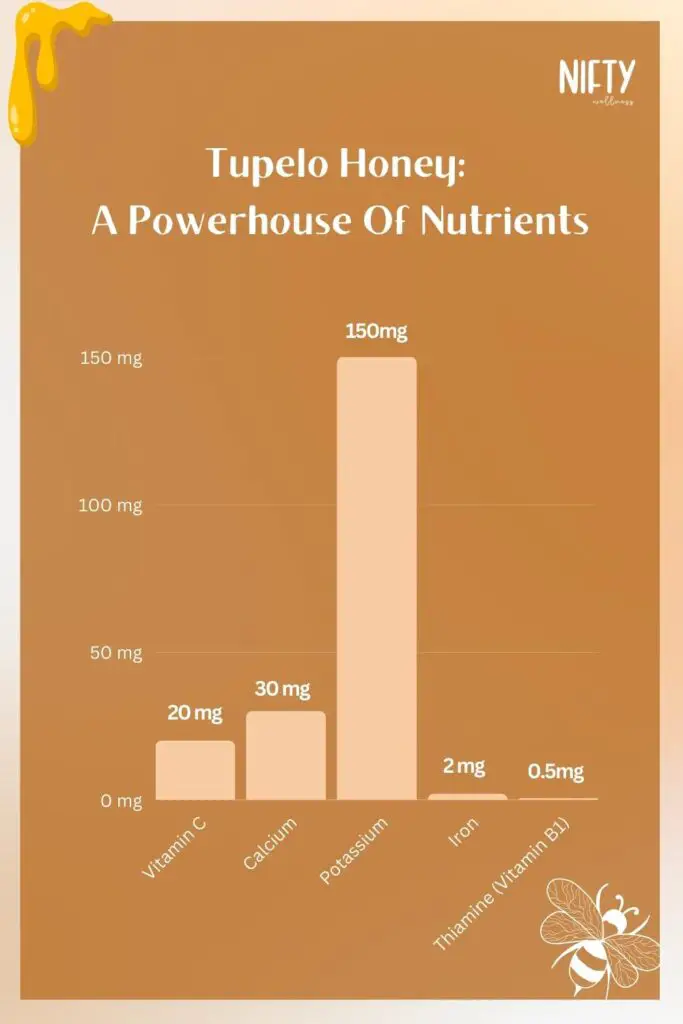
Tupelo honey is a nutrient powerhouse. Packed with antioxidants, it helps combat oxidative stress and free radical damage, contributing to better health. Tupelo honey is loaded in micronutrients like amino acids and antioxidants and essential vitamins and minerals like Vitamin C, calcium, potassium, iron, thiamine, and more. All of which work to keep the body healthy and strong. These nutrients play vital roles in various bodily functions, ensuring that Tupelo honey is not just a delightful treat but also a beneficial addition to your diet.
Immune Boosting
Tupelo honey, like other raw honeys, contains nutrient-dense compounds like bee pollen and propolis.
Propolis, or the collected glue material produced by bees, contains polyphenol antioxidants such as flavonoids shown to support a well-balanced, properly functioning immune system.
Regular consumption of Tupelo honey can help keep your immune system robust, making it an excellent choice to support your health. This is handy during flu season or when you need an extra boost.
Supports Healthy Digestion

Tupelo honey is antibacterial and rich in gut-healthy enzymes that support a healthy digestive system. Its natural carbohydrates and enzymes support a healthy microbiome that keeps gut-friendly bacteria alive and well-functioning. It serves as a natural prebiotic, providing essential nourishment for the beneficial bacteria in your gastrointestinal tract. This, in turn, supports efficient digestion and the absorption of nutrients. If you experience digestive concerns, integrating Tupelo honey into your diet can aid in alleviating discomfort and regulating your digestive processes. It offers a delicious and sweet means to maintain the well-being of your gastrointestinal system, making it a delightful daily addition.
Healthy Skin
Additionally, the benefits of Tupelo honey extend to your skin. Due to its rich antioxidant content and natural humectant properties, it can be applied topically to help hydrate and rejuvenate your skin, leaving it with a healthy and radiant glow. Tupelo honey’s rich bounty of antioxidants such as flavonoids, phenolic acids, and Vitamin C support radiant, healthy-looking skin.
Antioxidants have regenerative properties that fight off damaging free radicals and protect the skin from dangerous UV radiation that causes premature aging, dull skin, hyperpigmentation, and even skin cancer.

Read our blog Myomin Benefits & Side Effects: Is It Powerful. Uncover the potential of Myomin with its wonderful benefits and some side effects!
Conclusion
Tupelo honey stands out as a remarkable honey variety that not only delights the taste buds but also offers a range of health benefits. Its origins in the swamps of North Western Florida and Southern parts of Georgia make it a truly unique and rare honey. With its high fructose content, Tupelo honey provides a sustained release of energy, making it a natural source of sugar for athletes and those with specific dietary needs.
Additionally, its rich nutrient profile, immune-boosting qualities, and support for healthy digestion make it a versatile addition to your diet. Moreover, Tupelo honey’s bounty of antioxidants contributes to healthy, radiant skin, protecting against the effects of free radicals and UV radiation. So, whether you savour its delightful flavour or reap its health benefits, Tupelo honey is indeed the “Queen of the Honey World” in more ways than one.
Frequently Asked Questions

What’s So Special About Tupelo Honey?
Tupelo honey is a rare honey whose unusually high fructose content (compared to all other types of honey) means it does not crystallize. Its unique sugar ratio also means that some diabetics are able to eat this honey.
Where Does Tupelo Honey Come From?
While some may believe that Tupelo honey comes from Tupelo, Mississippi, the honey actually derives from the Ogeechee Tupelo swamp trees in specific parts of Northwestern Florida and Southern Georgia.
Why Is It Called Tupelo Honey?
Tupelo honey is named after the Tupelo swamp trees from which it derives. These White Ogeechee Tupelo trees are also known as Sour Tupelo-Gum, Bee-Tupelo, Ogeechee-Lime Tree, Tupelo Gum, or Swamp Gum.
How Do Beekeepers Harvest Tupelo Honey?
Beekeepers will often place platforms or “bee yards” near and around the Tupelo trees that make it easier for them to farm. Taking care of the hives is a difficult task, especially since the Tupelo trees reside in deep swampy waters.
Beekeepers also frequently use boats to travel to and from these hot and remote waters to reach these bee yards.
What Does Tupelo Honey Taste Like?
Tupelo honey has a bright floral taste with hints of fruit that, for some, resembles the flavor of Juicy Fruit gum, cotton candy, or rosewater. Its unique taste and wonderful aromas make Tupelo honey a favorite among any who try it.
What Goes Well with Tupelo Honey?
Tupelo honey has a brilliant, fruity-floral taste that can be used to sweeten a variety of different drinks and dishes. It is a great tea sweetener, balances out the flavors of strong blue cheeses, brightens the freshness of fruit, and works well in southern dishes such as barbeque, coleslaw, and biscuits.
Can Diabetics Eat Tupelo Honey?
Many physicians have given their diabetic patients the A-Okay to consume Tupelo honey. This is due to its high fructose to glucose ratio.
Where Can I Buy Tupelo Honey?
Due to its rarity and small location range, it’s not likely that you’ll find Tupelo honey in your local grocery store. Nowadays you can do a quick search on the Internet to find vendors and other specialty honey stores that can ship the honey to your home.
If you are in the parts of Florida and Georgia where Tupelo honey is produced, you may be able to find some high-quality, local Tupelo honey.
Is Raw Honey Safe to Eat?
Raw honey, also called natural honey, is completely safe to eat and is actually more healthy than “regular” or store-bought honey.
Raw honey is minimally processed and unpasteurized, so it retains bee pollen, beeswax, propolis, and other micronutrients that make natural honey incredibly nutritious.
